Slope stabilization planting in sunken gardens utilizes deep-rooted vegetation to prevent soil erosion and enhance landscape durability. These plants anchor the soil, reducing the risk of landslides and maintaining the garden's structural integrity. Selecting native species promotes ecological balance while providing aesthetic appeal and habitat for local wildlife.
Understanding Slope Challenges in Sunken Gardens
Slope stabilization planting in sunken gardens addresses unique challenges such as soil erosion, water runoff, and limited sunlight due to depth. Selecting deep-rooted, drought-tolerant plants enhances soil cohesion, reduces erosion risks, and manages excess water efficiently. Implementing native species adapted to specific microclimates within the garden further improves slope resilience and ecological balance.
Importance of Slope Stabilization for Garden Longevity
Slope stabilization planting is essential for preventing soil erosion and maintaining the structural integrity of a sunken garden. Deep-rooted plants and ground covers enhance soil cohesion, reducing landslide risks and preserving landscape aesthetics. Effective slope stabilization directly contributes to the garden's longevity by protecting its soil profile and supporting sustainable growth.
Assessing Soil Types and Drainage in Lowered Landscapes
Evaluating soil types and drainage patterns is crucial for effective slope stabilization planting in sunken gardens. Sandy loam soils with good permeability support deep root growth, while clay soils require careful management to prevent waterlogging. Proper assessment informs plant selection and erosion control strategies, ensuring long-term slope integrity in lowered landscapes.
Effective Planting Strategies for Slope Stabilization
Effective planting strategies for slope stabilization focus on selecting deep-rooted vegetation such as vetiver grass, native shrubs, and groundcovers that enhance soil cohesion and reduce erosion. Incorporating a diverse mix of drought-tolerant and fast-growing species provides continuous soil coverage, minimizing runoff and improving slope resilience. Proper spacing, layering of plants, and maintenance techniques like mulching are essential to promote healthy root development and long-term stability in sunken garden slopes.
Best Groundcover Plants for Erosion Control
Slope stabilization planting in sunken gardens effectively uses groundcover plants such as creeping juniper, vinca minor, and creeping phlox to prevent soil erosion. These species create dense mats that reduce runoff velocity and protect the soil surface from displacement. Selecting native, deep-rooted plants enhances slope integrity while promoting a resilient, low-maintenance landscape.
Deep-Rooted Shrubs and Grasses for Sunken Garden Slopes
Deep-rooted shrubs and grasses are essential for slope stabilization in sunken gardens, as their extensive root systems reinforce soil structure and prevent erosion. Species such as vetiver grass and native deep-rooted shrubs like ceanothus or mountain laurel anchor the soil effectively on steep slopes. Integrating these plants enhances slope durability while promoting biodiversity and aesthetic appeal within the sunken garden landscape.
Native Plant Selection for Sustainable Slope Plantings
Selecting native plants for slope stabilization in sunken gardens enhances soil retention and prevents erosion through deep root systems adapted to local conditions. Species such as California lilac (Ceanothus spp.), yarrow (Achillea millefolium), and red osier dogwood (Cornus sericea) provide effective ground cover and promote biodiversity while requiring minimal irrigation. These native plants improve slope resilience by stabilizing soil naturally, reducing maintenance costs, and supporting sustainable landscaping practices.
Combining Hardscape Features with Plantings for Stability
Slope stabilization planting in sunken gardens efficiently integrates hardscape features such as retaining walls, terraces, and rock formations with deep-rooted vegetation that anchors soil and prevents erosion. Choosing plants like native grasses, ground covers, and shrubs with extensive root systems enhances slope stability and complements structural elements by absorbing water and reducing runoff. This combined approach not only reinforces soil integrity but also creates a visually appealing landscape that balances function and aesthetic value.
Mulching and Soil Amendments for Enhanced Erosion Protection
Slope stabilization planting in sunken gardens benefits significantly from mulching techniques that reduce surface runoff and protect soil structure. Organic mulches such as wood chips or straw improve moisture retention and promote beneficial microbial activity, enhancing soil fertility and plant root growth. Incorporating soil amendments like compost or biochar further strengthens soil cohesion, reduces erosion risks, and supports long-term slope stability in landscaped areas.
Maintenance Tips for Long-Term Slope Health in Sunken Gardens
Regular maintenance of slope stabilization planting in sunken gardens includes consistent watering, especially during dry periods, to promote deep root growth and prevent soil erosion. Pruning and removing invasive species help maintain plant health and prevent competition that could destabilize the slope. Periodic inspection for signs of soil movement or plant stress allows for timely intervention, ensuring long-term slope stability and garden beauty.
Slope stabilization planting Infographic

 gardenot.com
gardenot.com